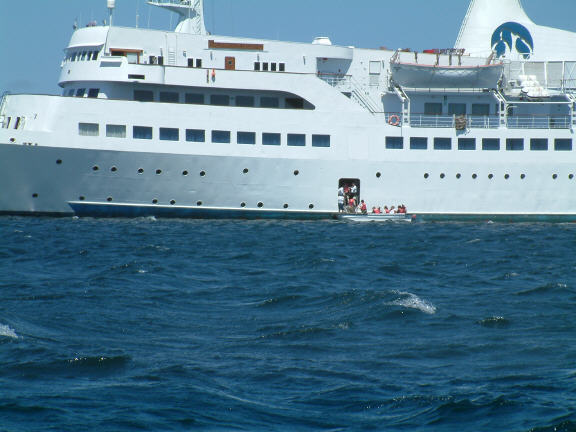
Our ship, the Legend, was anchored about a half-mile offshore; we had to board dinghies to take us to the ship. Cruise ships don't dock in the Galapagos Islands, probably to minimize the impact on the environment. By law, they are limited to 100 passengers. Ecuadorian authorities also keep track of how many visitors on on the islands at any one time.
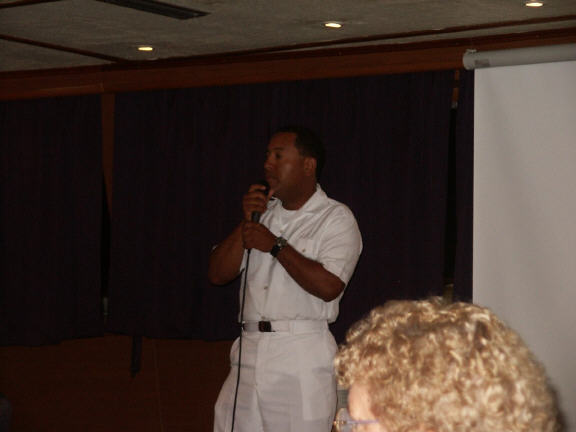
The first order of business, after the mandatory life vest and life boat drill, was a welcome and orientation meeting. One of the six naturalist guides on the Legend said we were in for an adventure. We weren't surprised by the worldview statement he shared so easily: "You will encounter surprises in the Galapagos Islands. Evolution is incredible; there is a great variation of animals and plants here that are found nowhere else."
While it's true that there IS a marvelous variety of unique animals and plants here, the "incredible" source isn't evolution, but God's marvelous design that allowed for such variation to develop from within the original created kinds.
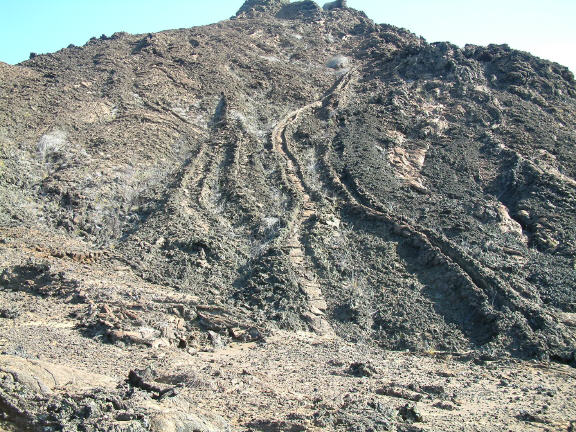
Bartolome is a fairly recent volcanic island; our guide estimated it to be only 10,000 years old. The current estimate for the oldest island is three million years old.
The landscape was extremely stark and moon-like, as it's often described. Very little vegetation, very little animal life.
The island is nothing but volcanic rock, produced by volcanic eruptions. It easily shows its natural history of the previous lava flows that created this new island. Here are three lava tubes, each about three to four feet across, that had collapsed at some point in the past.
Liquid moving downhill, in this case lava, can flow in rivulets. The outside of those lava flows sometimes cools faster than the inside, producing a tunnel-like lava tube. After everything cools down, the top of the tube just collapses onto the bottom, producing what may look like water slides but you sure wouldn't want to slide down them--it's all sharp and VERY hard rock!
Later in the week (Sunday) we were able to walk through a lava tube that is so large you can walk six or seven abreast in it.
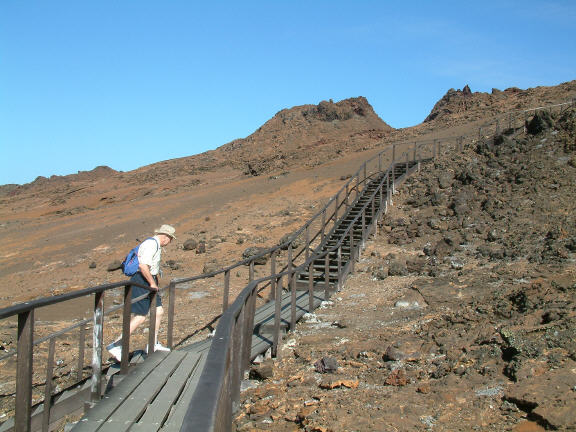
We followed a path that was sometimes just along dusty lava formations, but mostly was on a wooden stairway that rose about 300 feet above the sea. There are 382 steps to climb to get to the top!
The stairway/walkway wasn't build for tourists' ease of walking, but to protect the island from erosion as many thousands of people walk up and down the mountain each year.
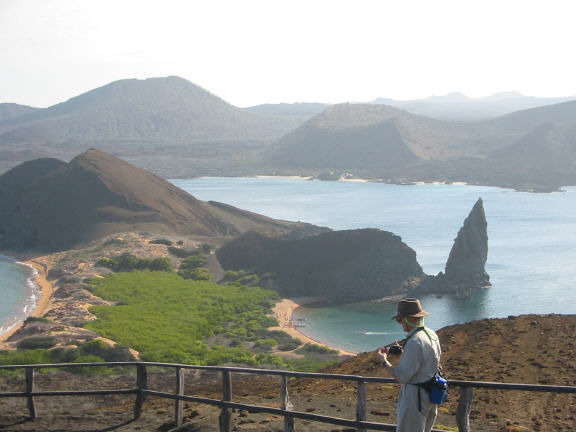
As we descended, we could see the destination for the next part of our excursion--the crescent beach in the shadow of Pinnacle Rock far below, with two dinghies and a number of other passengers from our ship. It would be our first opportunity to go snorkeling.
In the distance is the larger island of Santiago. The interesting shapes of the hills and mountains were all created from volcanic activity, many years before Bartolome was made. You can see that there is far more vegetation on the older island.
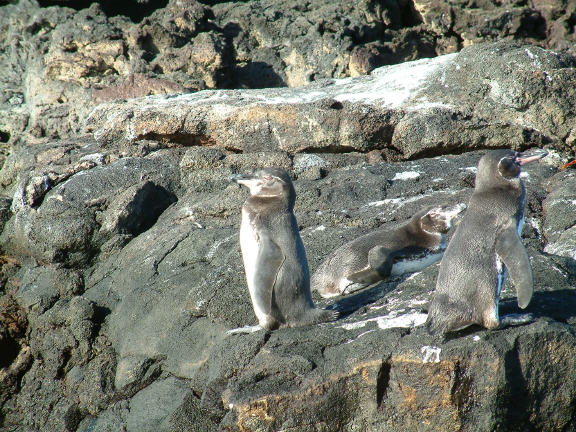
This was our first encounter with the Galapagos penguin, which is found only in Galapagos and is the most northerly penguin in the world. The penguins live where the water is colder and where they can find good shelter from the equatorial sun. The total population consists of only a few thousand birds.
We were able to get quite close. The animals didn't care--they aren't afraid of people. It's amazing how close they let you get. That's one reason the park guides have to tell you not to touch the animals, because they will let you!
The animals' lack of fear of man is like a peek at what life was like on earth before the Fall: lots of cooperation, cohabitation of various animals, and friendliness all around!
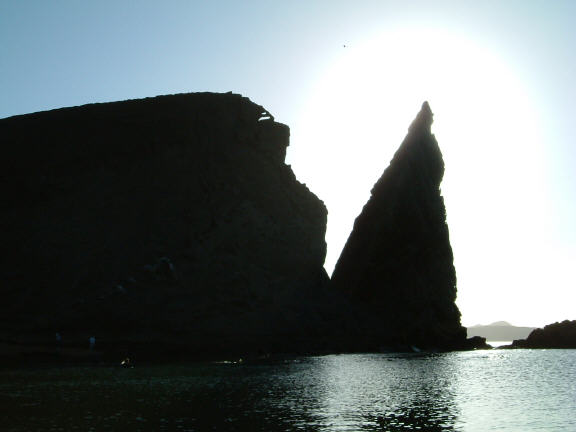
Unfortunately, by the time we got there it was late in the afternoon and the shadows of the surrounding rocks into the water made it difficult to see much. Those who ventured a little farther out from the beach said they saw a sea lion or two in the water, a penguin, and one even said he saw a white-tipped shark.
By then it was close to 6 p.m., the sun was going down, and it was a short dingy ride back to the ship. Because the Galapagos Islands are on the equator, there is very little variation in the amount of sunlight year-round. They only get about twelve hours of daylight. Dinner was at 8:00. Since we'd been up since our wake-up call in our Quito hotel at 4:15 a.m., that was a very full day. We were pretty beat at dinner.
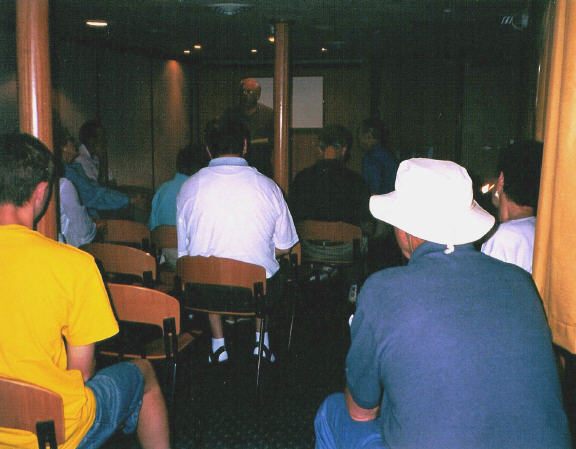
Following dinner we had a short meeting at with Dr. Ken Cummings of ICR, the tour leader, who talked to us about the timeline of history. His essential point was that (young-earth) creationists have only at minimum 6,000 years to fit in all of these geological and biological events that we're seeing at the Galapagos Islands. He made the point that that is a major challenge; that's why we would come here, to begin the process of trying to discover how to explain the unique things we see here.
He also talked about vestigial organs. Since 1896, all that had formerly been described as vestigial have now been understood to have a function. This was to show us how our current understanding of what we see does not necessarily equate to fact, and as we get more information the picture can change dramatically.
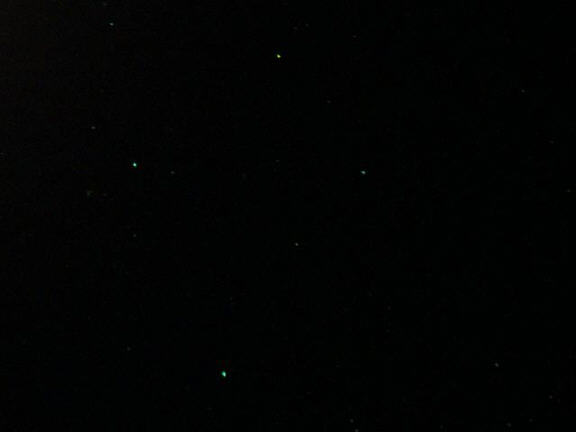
This first night onboard the ship was also the night of a total lunar eclipse. At about 10:15, one of the women who had been monitoring the status of the eclipse asked for a break in the lecture to watch the moon get completely covered by the earth's shadow. Because the sky was so dark, despite the fact that we had a full moon, we saw amazing numbers of stars, including the Southern Cross (shown here) and other constellations we had never seen before. From the top deck of the ship we were able to behold the Milky Way in its celestial glory.
For a group of creationists, what a delight it was for us to meditate on the beauty of Psalm 8:3-4:
"When I consider Your heavens, the work of Your fingers,
The moon and the stars, which You have ordained;
What is man that You take thought of him,
And the son of man that You care for him?"
What a great way to start our adventure!